Top 10 Best Kitchen Herbs to Grow for Fresh Flavors
Growing your own kitchen herbs is a delightful way to add fresh flavors to your cooking. The top 10 herbs to ponder are basil, rosemary, thyme, oregano, cilantro, mint, parsley, chives, sage, and dill. These herbs are easy to grow, require minimal maintenance, and offer a range of flavors from bold to delicate. You’ll find basil perfect for Italian dishes, rosemary ideal for roasted meats, and cilantro essential for zesty salsas. Most of these herbs thrive in well-draining soil and full sun, making them suitable for both indoor and outdoor cultivation. Discover how these aromatic plants can transform your culinary creations and elevate your home-cooked meals.
This post may contain affiliate links. If you make a purchase through these links, I may earn a commission at no additional cost to you. Additionally, portions of this post may be generated using artificial intelligence (AI) technology. While we strive for accuracy, please be aware that AI-generated content may not always be perfect and should be fact-checked when necessary.
The Spatula Scoop
- Basil, rosemary, thyme, oregano, and cilantro are easy to grow indoors year-round with minimal maintenance.
- Mint, parsley, and chives thrive in various conditions and add unique flavors to diverse dishes.
- Sage and dill offer distinctive tastes and have versatile culinary applications in Mediterranean and other cuisines.
- Many of these herbs, like rosemary and oregano, possess antimicrobial properties that can naturally preserve food.
- Regular harvesting of most herbs encourages bushy growth, ensuring a continuous supply of fresh flavors for cooking.
Basil: The Versatile Italian Favorite
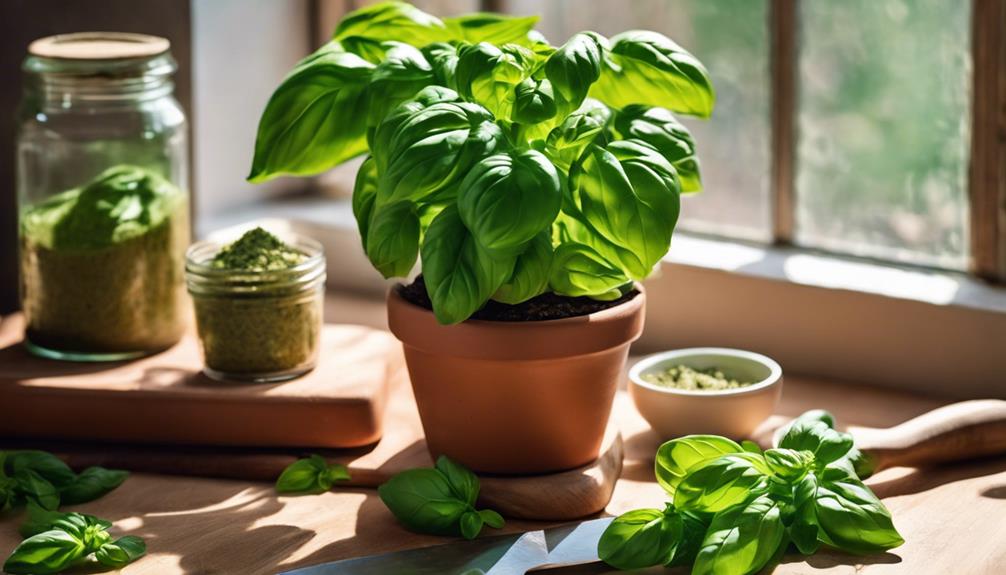
One of the most beloved herbs in Italian cuisine, basil is a versatile and easy-to-grow plant that’s perfect for both novice and experienced gardeners. This warm-season crop thrives in temperatures between 60°F and 80°F, making it an ideal addition to your kitchen herb collection. You can grow basil indoors year-round, guaranteeing a constant supply of fresh leaves for your culinary creations.
Basil’s sweet, slightly spicy flavor pairs wonderfully with tomatoes, mozzarella, and olive oil, making it a staple in many Italian dishes. From classic pesto to caprese salads and homemade pasta sauces, this herb will elevate your cooking with its distinctive taste.
To get started, you can sow basil seeds indoors 4-6 weeks before the last frost date or directly in your garden in late spring. As your plants grow, remember to pinch off flower buds and prune regularly to encourage bushy growth and guarantee a continuous harvest of fresh leaves. With over 160 varieties available, including sweet basil, Thai basil, and lemon basil, you’ll find the perfect type to suit your taste and kitchen needs.
Rosemary’s Aromatic Mediterranean Charm
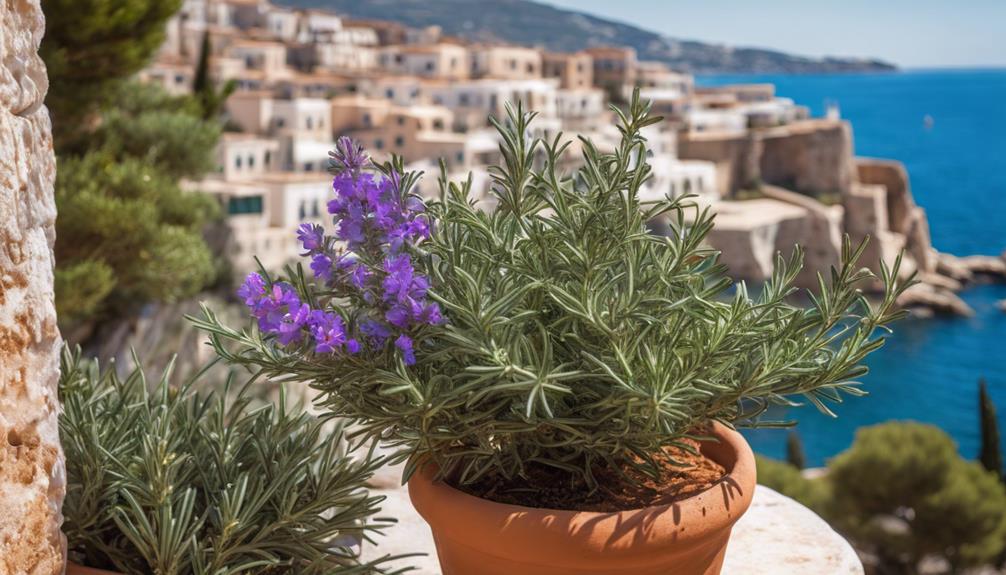
Few herbs capture the essence of Mediterranean cuisine quite like rosemary. This aromatic Mediterranean herb is a low-maintenance addition to your indoor herb garden, thriving in full sun and well-draining soil. With its evergreen nature and potential to grow up to 4 feet tall, rosemary can become a stunning centerpiece in your kitchen garden or herb containers.
You’ll love the versatility of rosemary in your cooking. Its piney, slightly bitter flavor pairs wonderfully with roasted meats, vegetables, and breads. Don’t forget to try it in herbal teas and potpourri for a delightful aroma. Harvesting is a breeze – simply pinch or cut off individual fresh leaves or stems as needed. Use them immediately or dry them for later use in soups, stews, and sauces.
Beyond its culinary uses, rosemary boasts natural antiseptic and anti-inflammatory properties, making it a popular ingredient in skincare products and natural remedies. By growing this Mediterranean herb, you’re not only adding flavor to your dishes but also bringing a touch of the Mediterranean to your home and potentially enhancing your well-being.
Thyme for Every Dish
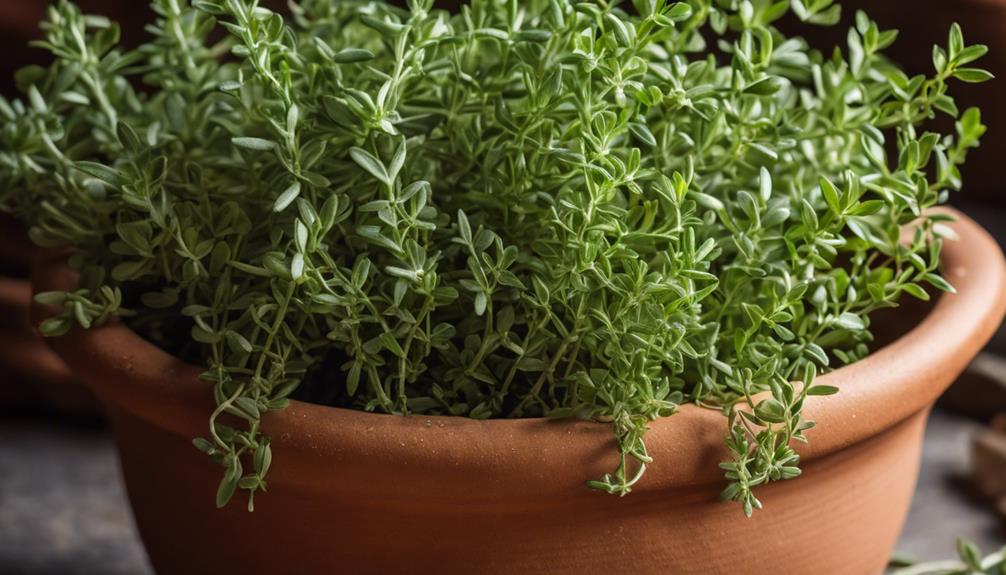
As versatile as it is aromatic, thyme is a must-have herb for any kitchen garden. This easy-to-grow plant thrives in well-drained soil and full sun, making it perfect for both indoor and outdoor cultivation. You’ll love how thyme adds flavor to a wide range of dishes, from soups and stews to meat and vegetable recipes.
One of thyme’s unique qualities is its antibacterial properties, which can help preserve food and prevent spoilage. Use it in homemade sauces and marinades to extend their shelf life naturally. In the garden, thyme acts as a natural pest repellent, protecting your other plants from unwanted visitors.
| Thyme Benefits | In the Kitchen | In the Garden |
|---|---|---|
| Versatile | Adds flavor | Pest repellent |
| Antibacterial | Preserves food | Companion plant |
| Low-maintenance | Fresh or dried | Continuous harvest |
To keep your thyme plant thriving, harvest it regularly throughout the growing season. This encourages bushy growth and prevents flowering, ensuring a continuous supply of flavorful leaves. Whether you’re using it fresh or dried, thyme will become an indispensable part of your culinary repertoire, adding depth and complexity to your dishes year-round.
Oregano’s Bold Flavor Profile
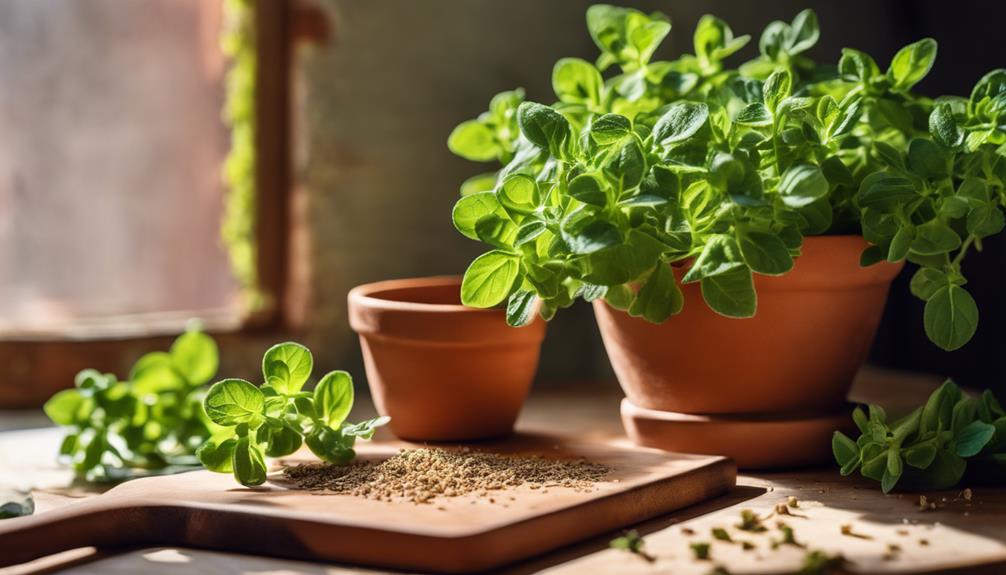
You’ll find oregano’s bold, earthy flavor indispensable in your kitchen, enhancing everything from pizzas to pasta sauces. Growing oregano indoors is a breeze, as this hardy herb thrives in well-drained soil and full sun, making it perfect for a sunny windowsill or countertop garden. Whether you choose the milder Italian variety or the more pungent Greek oregano, you’ll have a versatile herb at your fingertips for countless culinary creations.
Culinary Uses of Oregano
Oregano’s bold flavor profile stands out in the culinary world, offering an earthy, pungent, and slightly bitter taste with warm, aromatic undertones. As one of the most versatile herbs in your kitchen garden, oregano is a staple in Mediterranean cuisine. You’ll find it commonly used to season tomato-based sauces, pizzas, and grilled meats, adding depth and complexity to these dishes.
When you’re looking to enhance your cooking, oregano shines in combination with other herbs like thyme, rosemary, and basil. It’s an excellent way to add flavor to soups, stews, and braises, intensifying the overall taste of your meals. You can use fresh oregano leaves as a garnish or incorporate them into salads, soups, and sauces for a vibrant burst of flavor. If you’re working with dried oregano, it’s perfect for spice blends and rubs.
Don’t overlook oregano’s practical benefits, either. Its essential oils possess antimicrobial properties, making it a natural preservative in many recipes. By growing oregano in your kitchen garden, you’ll always have this flavorful and versatile herb on hand to elevate your culinary creations.
Growing Oregano Indoors
Now that you’re familiar with oregano’s culinary uses, let’s explore how to grow this flavorful herb indoors. Oregano grows best in a south- or west-facing window that receives direct sunlight throughout the day. This versatile kitchen herb thrives indoors with proper care and attention.
To guarantee your oregano flourishes, follow these key guidelines:
| Care Aspect | Instructions |
|---|---|
| Sunlight | Direct, 6-8 hours daily |
| Watering | Consistent moisture, well-draining soil |
| Pruning | Pinch stem tips regularly |
| Fertilizing | Balanced fertilizer occasionally |
| Replanting | Divide and replant every 2-3 years |
When growing oregano indoors, provide consistent moisture while certifying the soil drains well to prevent waterlogging and root rot. To promote bushy growth and maintain its bold flavor profile, pinch or cut off the stem tips regularly. This also prevents flowering, which can alter the herb’s taste.
Oregano is a low-maintenance herb, making it perfect for indoor kitchen gardens. With occasional pruning and fertilization, you’ll have a thriving plant that adds earthy, warm flavors to your Italian and Greek dishes. By following these simple care instructions, you’ll enjoy fresh oregano year-round, elevating your culinary creations with its aromatic leaves.
Cilantro: Fresh and Zesty
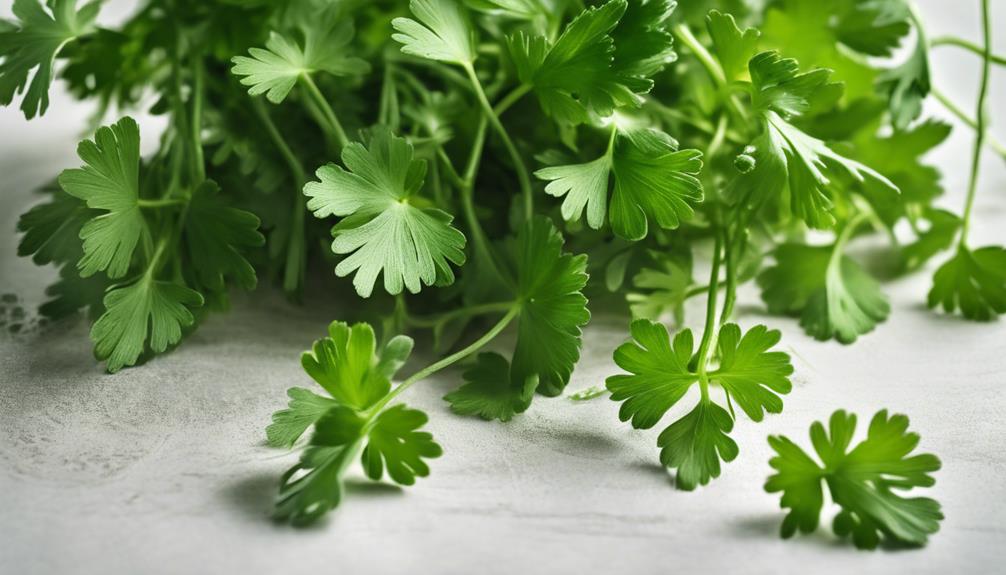
Bursting with fresh, citrusy flavor, cilantro is a versatile herb that’s essential in many global cuisines. You’ll often find it in Mexican, Indian, and Asian dishes, adding a zesty kick to salsas, salads, and chutneys. Whether you’re using it raw or in your cooking, cilantro’s distinctive taste can elevate your meals to new heights.
Growing cilantro is a breeze, making it perfect for both indoor and outdoor gardens. You can sow seeds directly in well-draining soil or start them indoors 2-3 weeks before the last frost. Choose a spot with partial shade for ideal growth. Once your cilantro sprouts, you’ll want to harvest it within 3-4 weeks to prevent bolting. Regular pruning encourages bushy growth and extends your harvest throughout the season.
To keep a steady supply of fresh cilantro, consider planting new seeds every few weeks. This way, you’ll always have young, flavorful leaves on hand. Don’t forget about the seeds, either – they can be dried and ground into coriander, a popular spice in its own right. With its versatility and ease of growth, cilantro is a must-have herb for any home cook’s garden.
Mint: Cool and Refreshing
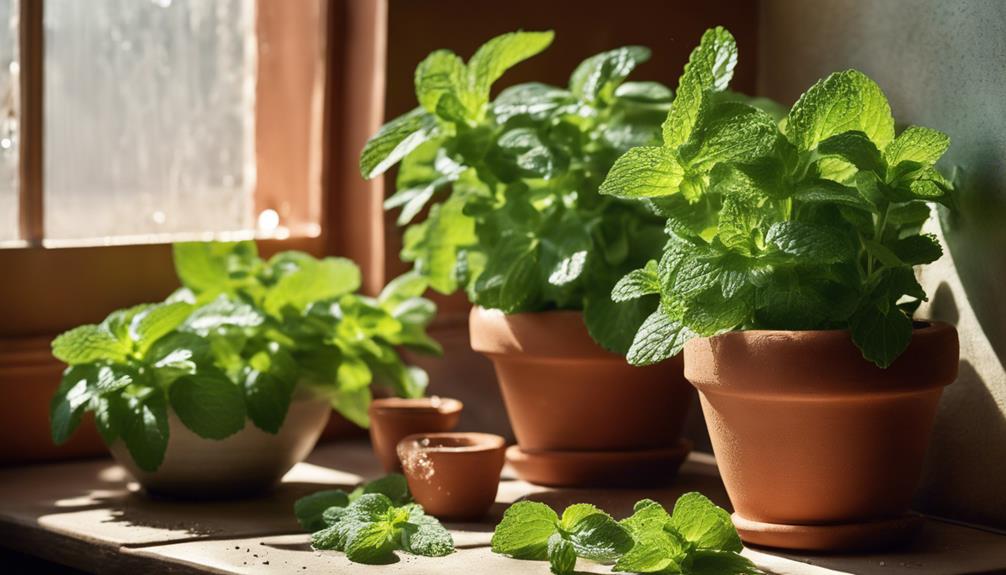
While cilantro adds a zesty kick to your dishes, mint brings a cool, invigorating touch to your culinary creations. This versatile herb is a must-have in your kitchen garden, offering over 600 varieties to choose from. Peppermint and spearmint are the most popular for cooking and teas, but you’ll find endless possibilities to experiment with.
Growing mint is easy, but be cautious—it’s a hardy perennial that can quickly take over your garden. To keep it under control, consider planting it in containers. This way, you’ll always have fresh mint on hand without worrying about it invading other plants.
Mint’s cooling properties make it perfect for various uses:
- Add it to teas and cocktails to soothe indigestion and nausea
- Use it as a revitalizing garnish for salads and desserts
- Incorporate it into skincare products for its antibacterial benefits
When you grow mint, you’ll have a constant supply of this aromatic herb to enhance your culinary creations and boost your overall well-being. Its versatility in the kitchen and beyond makes it an excellent choice for any home gardener looking to cultivate fresh, flavorful herbs.
Parsley’s Bright and Colorful Appeal
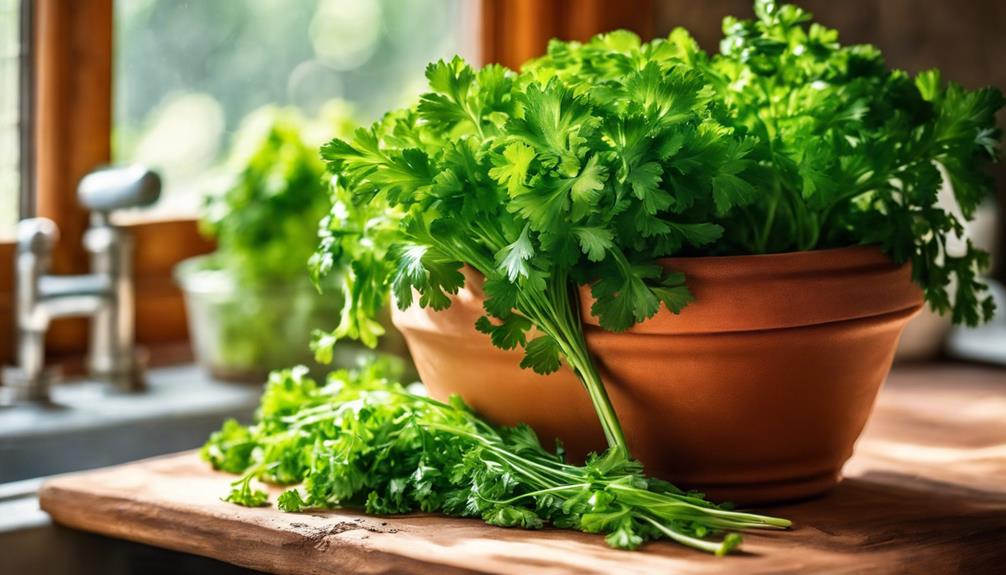
Parsley, with its vibrant green leaves and fresh flavor, adds a pop of color and taste to any dish. When growing fresh herbs, parsley is one of the best choices for both novice and experienced gardeners. You’ll find two popular varieties: curly-leaf and flat-leaf (Italian parsley). While curly-leaf is often used as a garnish, Italian parsley is preferred for cooking due to its stronger flavor.
This slow-growing herb is rich in vitamins A, C, and K, as well as potassium and iron, making it a nutritious addition to your meals. You can easily grow parsley indoors year-round on a windowsill or in a cooler part of your garden, as it prefers partial shade and cooler temperatures.
Parsley is a hardy biennial that thrives in USDA zones 3-9, and you can harvest it in as little as 6-8 weeks after sowing. To guarantee success, provide consistent moisture throughout its growth cycle. Whether you’re adding it to salads, soups, or sauces, parsley’s bright and colorful appeal will enhance both the visual appeal and flavor of your culinary creations.
Chives: Mild Onion Elegance
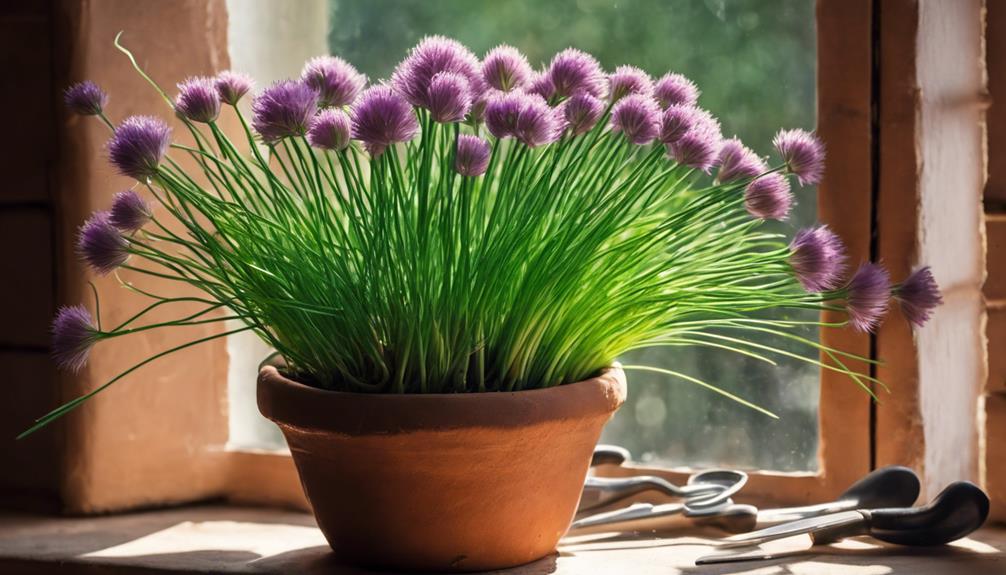
Chives offer a subtle yet sophisticated addition to your herb garden. These hardy perennials bring a mild onion flavor to your dishes without overwhelming them. You’ll love how easy chives are to care for, whether you’re growing them indoors or outdoors. They thrive in well-draining soil with partial sunlight and regular watering, making them perfect for both novice and experienced gardeners.
One of the best things about chives is their versatility in the kitchen. You can use them:
- As a fresh green garnish to add a pop of color and flavor
- In soups, salads, sauces, and dips for a delicate onion taste
- To create flavorful herb butters and vinegars
Chives are a low-maintenance herb that you can harvest continuously. Simply cut the leaves at the base of the plant to encourage new growth and prevent flowering. This guarantees a steady supply of fresh chives for your culinary creations. Not only do they add flavor to your dishes, but they’re also packed with vitamins A and C, potassium, and antioxidants, making them a nutritious addition to your meals.
Sage’s Earthy Depth
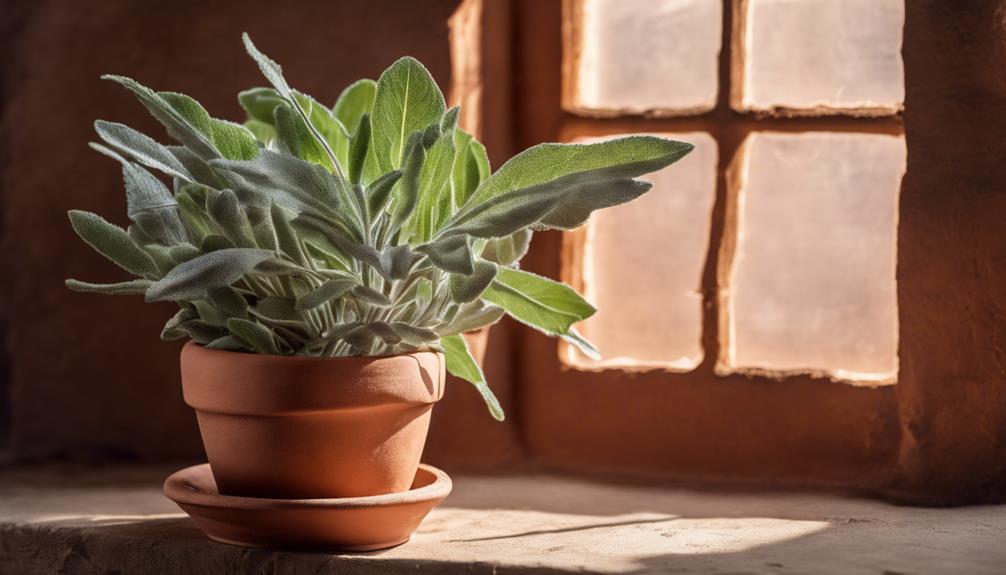
Ever wondered what gives stuffing its distinctive flavor? It’s sage, a hardy herb that brings earthy depth to your culinary creations. This perennial plant thrives in well-drained soil and full sun, making it an easy addition to your kitchen garden.
Sage’s unique taste comes from its high concentration of essential oils, particularly thujone. You’ll find this herb playing a starring role in Italian cooking and Mediterranean dishes, where its earthy flavor complements fatty ingredients in stuffing, sausages, and roasted meats.
Don’t limit yourself to traditional uses, though. Fresh sage leaves make an excellent garnish and can add depth to soups, stews, and braises. If you’re working with dried sage, it’s perfect for spice blends and rubs.
Beyond its culinary applications, sage boasts impressive medicinal properties. Its antioxidant and anti-inflammatory effects may improve cognitive function and reduce inflammation in your body.
When you grow sage, you’re not just adding a versatile herb to your kitchen arsenal; you’re cultivating a plant with a rich history of culinary and medicinal use. Its low-maintenance nature and multifaceted benefits make it a must-have for any home cook’s garden.
Dill: Delicate and Distinctive
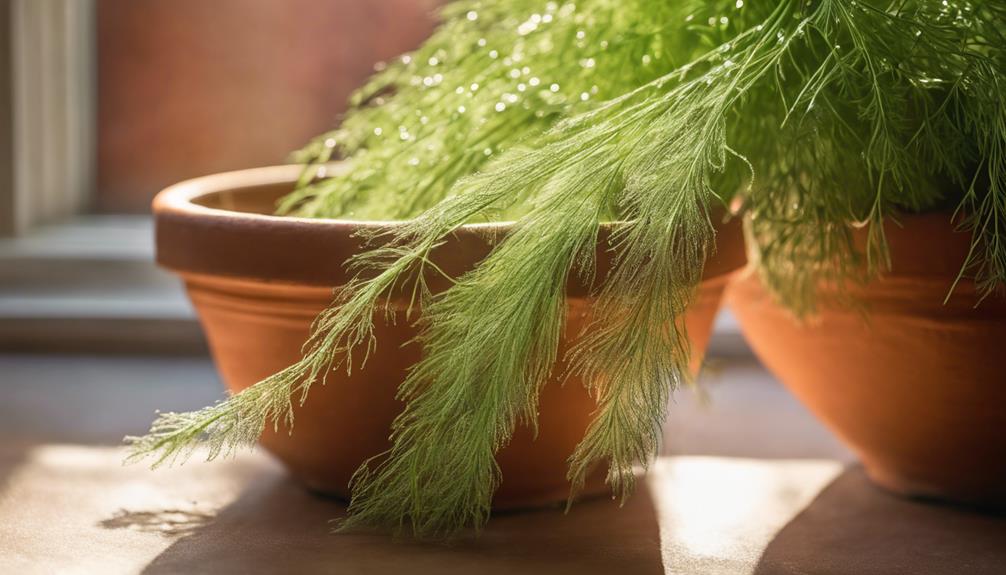
With its delicate, feathery leaves and distinctive flavor, dill is a must-have herb for any kitchen garden. This annual herb, which can grow up to 3 feet tall, is perfect for adding a fresh, tangy taste to your culinary creations. If you’re looking for herbs to grow that offer versatility and flavor, dill should be at the top of your list.
To successfully grow dill, follow these simple steps:
- Choose a sunny spot with well-drained soil in your garden.
- Plant seeds directly in the ground, 1/4 inch deep and 1-2 inches apart, after the last frost in spring or 8 weeks before the first frost in fall.
- Keep the soil consistently moist during germination and watch your dill thrive.
You’ll appreciate dill’s dual purpose as both a flavorful herb and a natural pest repellent. It’s an excellent companion plant for cucumbers, tomatoes, and other vegetables, helping to protect them from aphids and mites. When it comes to harvesting, you can pick fresh dill leaves at any time, but for the most intense flavor, harvest just before the plant flowers. Use your homegrown dill for pickling, sauces, and salads to elevate your dishes with its distinctive taste.
Frequently Asked Questions
What Herbs Grow Best in the Kitchen?
You’ll find several herbs that thrive in your kitchen. Basil, mint, and parsley are excellent choices, requiring minimal care and adapting well to small containers. Chives, rosemary, and thyme are low-maintenance options that’ll flourish with ample sunlight. Don’t forget oregano, cilantro, and dill, which can also grow indoors with proper attention. These herbs not only add fresh flavors to your dishes but also bring a touch of greenery to your kitchen space.
What Herbs Taste Best Fresh?
You’ll find that many herbs taste best when used fresh. Basil, cilantro, and parsley offer the most vibrant flavors right after harvesting. Mint, tarragon, and chives shine when added at the end of cooking, preserving their delicate taste and aroma. Soft herbs like basil and mint are ideal fresh, as they can become bitter when dried or cooked. For Mediterranean flair, try fresh oregano and thyme. If you’re into Scandinavian or Eastern European cuisine, fresh dill and chervil are excellent choices.
What Are the 10 Most Used Herbs?
You’ll find that the 10 most used herbs in kitchens worldwide are basil, parsley, cilantro, mint, rosemary, thyme, oregano, chives, dill, and sage. These versatile herbs add depth and flavor to a wide range of dishes. You can easily grow most of them at home, ensuring you’ll always have fresh herbs on hand. They’re not only delicious but also packed with health benefits. Experiment with these herbs to elevate your cooking and discover new flavor combinations.
What Are the Best Fresh Herbs to Grow?
If you’re looking to grow fresh herbs, you can’t go wrong with basil, cilantro, parsley, rosemary, and thyme. These versatile herbs are easy to cultivate and will add fantastic flavor to your cooking. Basil’s perfect for Italian dishes, while cilantro’s great for Mexican and Asian cuisine. Parsley’s a nutritious addition to many recipes, and rosemary’s ideal for roasted meats. Thyme’s a low-maintenance option that pairs well with various ingredients. Start with these, and you’ll have a thriving herb garden in no time!





